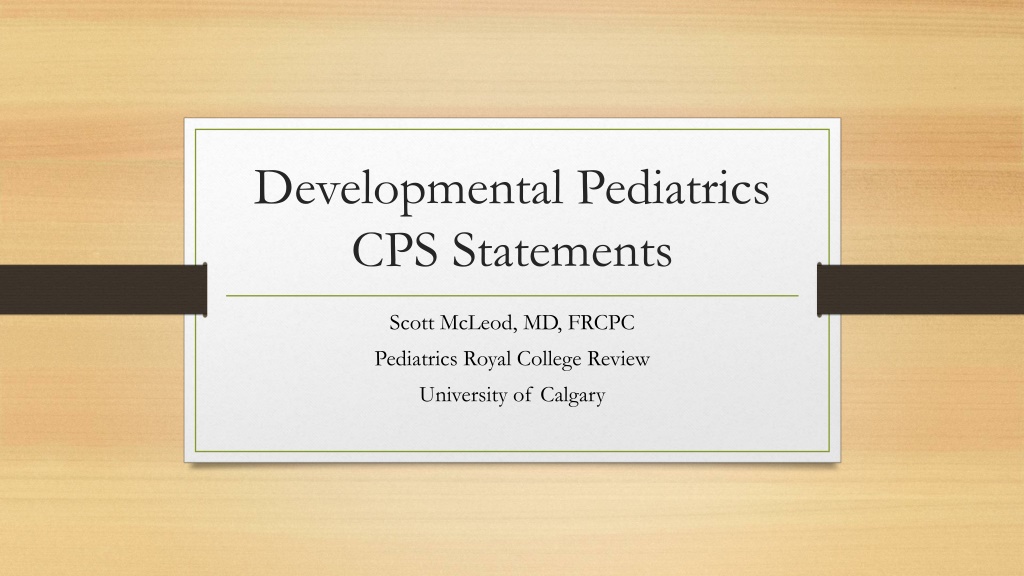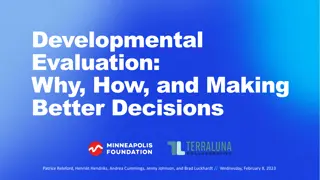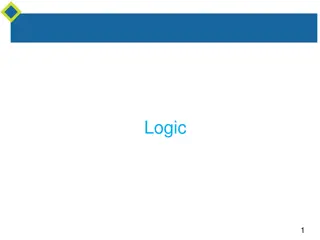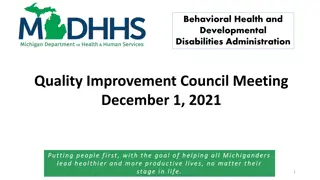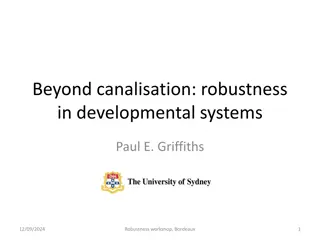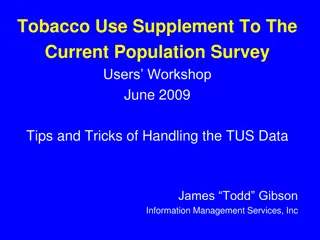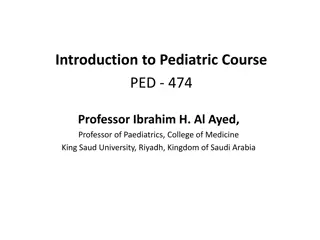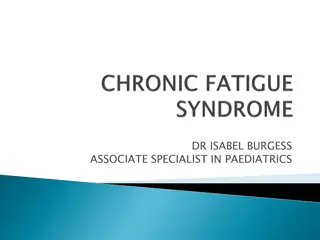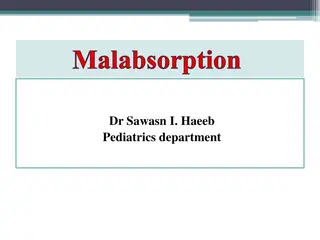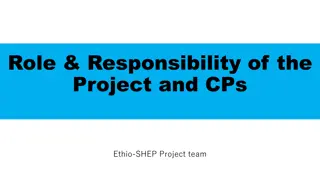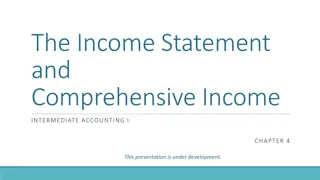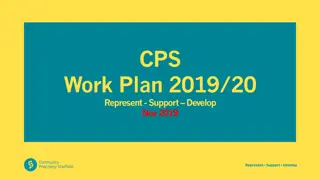Latest Updates in Developmental Pediatrics: CPS Statements Review
Covering the most recent Canadian Pediatric Society practice points and position statements in developmental pediatrics, this review addresses key topics like neonatal sensorineural hearing loss, risk factors, impact on development, and more. Gain insights into identifying hearing loss types, associated gastrointestinal complications, and the importance of early intervention. Stay informed about universal newborn hearing screening, genetic causes, and factors contributing to hearing loss in neonates. Understand the direct impact of hearing loss on a child's speech and language development.
Download Presentation

Please find below an Image/Link to download the presentation.
The content on the website is provided AS IS for your information and personal use only. It may not be sold, licensed, or shared on other websites without obtaining consent from the author. Download presentation by click this link. If you encounter any issues during the download, it is possible that the publisher has removed the file from their server.
E N D
Presentation Transcript
Developmental Pediatrics CPS Statements Scott McLeod, MD, FRCPC Pediatrics Royal College Review University of Calgary
Objectives Cover the most recent Canadian Pediatric Society (CPS) Practice Points/ Position Statements related to Developmental Pediatrics Review potential questions arising from the CPS Guidelines
Question #1 The children in the picture present to your pediatric clinic. Choose the best answer for the type of hearing loss and the most likely gastrointestinal complication to present in these children. 1. Conductive hearing loss, ileus 2. Sensorineural hearing loss, ileus 3. Sensorineural hearing loss, hirschprung 4. Conductive hearing loss, hirschprung
Question #1 The children in the picture present to your pediatric clinic. Choose the best answer for the type of hearing loss and the most likely gastrointestinal complication to present in these children. 1. Conductive hearing loss, ileus 2. Sensorineural hearing loss, ileus 3. Sensorineural hearing loss, hirschprung 4. Conductive hearing loss, hirschprung
Universal Newborn Hearing Screening Has been endorsed by most major preventative health task forces Hearing loss is a common congential disorder (1-3/1000) Measured by the degree of loss in decibels and at particular frequencies (125hz low pitch to 8000Hz high pitch) Most congenital hearing loss is sensorineural Genetic causes found in 50%
Risk Factors for Neonatal Sensorineural Hearing Loss Please list 4:
Risk Factors for Neonatal Sensorineural Hearing Loss Family history Craniofacial abnormalities Congenital infections (remember CMV) Physical findings consistent with a syndrome associated with hearing loss NICU stay >2 days Ototoxic drugs Exchange transfusion
Impact on Development A child s speech and language is directly proportional to the severity of hearing loss and the time between diagnosis and intervention
Screening Tests Otoacoustic Emissions Identifies conductive and cochlear hearing loss from the external ear to the level of the outer hair cells in the cochlea Auditory Brainstem Response Identifies conductive, cochlear, and neural hearing loss to the level of the brainstem Often UNHS is a 2-step process
Developmental Impact of Treatment Those that received interventions before 6 months scored 20-40 percentile points higher on school-related measures Various interventions: Hearing aids, cochlear implants, surgery to correct malformations of the ear, wireless devices (FM systems) Early promotion of oral and gestural communication
Question #2 A child presents to your clinic. She is of low socioeconomic background and her family are newcomers to Canada. Both English and Arabic are spoken in the household. They prefer to buy English films rather than books. Of the following, what puts this child at the greatest risk for difficulties with reading at school? 1. Low socioeconomic status 2. Being a newcomer to Canada 3. Both languages being spoken in the home 4. Not being read to
Question #2 A child presents to your clinic. She is of low socioeconomic background and her family are newcomers to Canada. Both English and Arabic are spoken in the household. They prefer to buy English films rather than books. Of the following, what puts this child at the greatest risk for difficulties with reading at school? 1. Low socioeconomic status 2. Being a newcomer to Canada 3. Both languages being spoken in the home 4. Not being read to
Read, speak, sing: Promoting literacy in the physician s office Low literacy is a severe and pervasive problem in Canada Health, social and economic consequences Preschoolers who are read to are significantly more likely to have the literacy skills required for early school success
High Risk Groups Recent newcomers to Canada Aboriginal peoples Youth (16-25 year olds) Low socio-economic status
Health consequences of Low Literacy Incorrect use of medications Failure to comply with medical directions Errors in administration of infant formula Safety risks in the community Higher rates of poverty Higher stress Unhealthy lifestyle practices: smoking, nutrition, physical activity
Literacy and Language Development Early experiences shape brain architecture (synaptic pruning) Early language skills are primarily based on exposure (varies with socio- economic status) The richest language exposure occurs during reading, especially with dialogue reading
Question #3 You are managing an adolescent with ADHD in your practice. He has been taking an extended release methylphenidate for the last 2 years. He presents today complaining of a shortened attention span and mild anxiety. You suggest a change to his medication. What will you do? 1. Prescribe an adjunct medication such as guanfascine XR. 2. Prescribe an increased dose of methylphenidate and reassess. 3. Prescribe an SSRI to treat his co-occurring anxiety. 4. Prescribe Atomoxetine to treat both anxiety and ADHD.
Question #3 You are managing an adolescent with ADHD in your practice. He has been taking an extended release methylphenidate for the last 2 years. He presents today complaining of a shortened attention span and mild anxiety. You suggest a change to his medication. What will you do? 1. Prescribe an adjunct medication such as guanfascine XR. 2. Prescribe an increased dose of methylphenidate and reassess. 3. Prescribe an SSRI to treat his co-occurring anxiety. 4. Prescribe Atomoxetine to treat both anxiety and ADHD.
Extended-Release Medication for Children and Adolescents with Attention-Deficit Hyperactivity Disorder ADHD is common (1 in 5 children) Extended release preparations are first line therapy for ADHD and are less likely to be diverted XR preparations are frequently expensive
Impact of ADHD Affected children are at increased risk of: Injuries Behavioral problems Academic problems Social problems Treatment is associated with decreasing the risk of drug or alcohol dependence
XR vs IR preparations Adverse effects of IR preparations: multiple daily doses stigma of taking a medication disruption to school routine Efficacy is similar for IR and XR preparations Compliance is better for XR XR preparations are less likely to be misused and are first line therapy
Question #4 The mother of a child you are seeing is concerned that her child is not able to sleep without her presence. What type of sleep disorder is this, and what is first line therapy? 1. 2. 3. 4. Behavioral insomnia, Melatonin Limit setting type insomnia, Sleep Hygiene Sleep onset association, Melatonin Sleep onset association, Sleep Hygiene
Question #4 The mother of a child you are seeing is concerned that her child is not able to sleep without her presence. What type of sleep disorder is this, and what is first line therapy? 1. 2. 3. 4. Behavioral insomnia, Melatonin Limit setting type insomnia, Sleep Hygiene Sleep onset association, Melatonin Sleep onset association, Sleep Hygiene
Melatonin for the management of sleep disorders in children and adolescents Difficulties in initiating sleep impact 15-25% of all children Up to 67% in children with Autism Spectrum Disorder The two most frequently encountered sleep disorders are delayed sleep phase type and behavioral insomnia of childhood Delayed sleep phase: time between lying down and onset of sleep is long Behavioural insomnia: sleep onset-association (special conditions are required) limit-setting type (unsuccessful limit-setting behaviors)
Management Sleep hygiene: stable bedtimes, dark space, avoiding hunger, relaxation, avoiding caffeine, avoidance of screen time Melatonin: administer melatonin 30-60 minutes prior to desired bedtime (typical doses 2.5-3 mg) One study of long-term melatonin use in children with ADHD (3.7 years) found no safety concerns
Question #5 You are seeing the family to the right in your clinic. What diagnosis is the child in the middle most likely to have? 1. Adjustment disorder 2. Separation anxiety 3. Depression 4. None of the above
Question #5 You are seeing the family to the right in your clinic. What diagnosis is the child in the middle most likely to have? 1. Adjustment disorder 2. Separation anxiety 3. Depression 4. None of the above
Supporting the Mental Health of Children and Youth of Separating Parents Separation and divorce may increase risks for negative outcomes in physical, mental, educational, and psychosocial well-being Consequences: During the early years attachment is forming, repeated or prolonged separation from a primary attachment figure because of shared-parenting may compromise attachment formation High intensity conflict may lead to the development of insecure attachment and disorganized attachment styles At 4-5 years old, children often blame themselves and become clingy separation anxiety, externalizing behaviors, excessive fears of abandonment are common Adolescence: personality and identity are consolidated and peers become the reference group for daily activities
Supporting the Mental Health of Children and Youth of Separating Parents Many children experience distressing thoughts, emotions, the overwhelming majority do not experience serious outcomes Children of divorced parents however, did score lower on measures of: Academic achievement Conduct Psychological adjustment Self-concept Social relationships Sometimes persists into adulthood education failure, unplanned pregnancy, marital discord
Recommendations for Pediatricians Use common sense here: Divorce can impact children Avoid taking sides Suggest mediation if there are ongoing conflictual relationships Encourage parents to monitor their own mental health Promote positive, consistent discipline
Question #6 You are treating a 13 year old girl in your pediatric office. She is frequently worried, has difficulty controlling her worries, and has some difficulty with muscle tension and concentration. Her past history is significant only for a repaired ventricular septal defect. You diagnose generalized anxiety disorder. She is receiving Cognitive Behavioral Therapy (CBT) and you are choosing to pursue medical therapy with Citalopram. What serious complication do you need to be aware of? 1. Prolonged QT interval 2. Supraventricular tachycardia 3. Atrial-ventricular dissociation 4. Torsades de points
Question #6 You are treating a 13 year old girl in your pediatric office. She is frequently worried, has difficulty controlling her worries, and has some difficulty with muscle tension and concentration. Her past history is significant only for a repaired ventricular septal defect. You diagnose generalized anxiety disorder. She is receiving Cognitive Behavioral Therapy (CBT) and you are choosing to pursue medical therapy with Citalopram. What serious complication do you need to be aware of? 1. Prolonged QT interval 2. Supraventricular tachycardia 3. Atrial-ventricular dissociation 4. Torsades de points
Use of Selective Serotonin Reuptake Inhibitor Medications for the Treatment of Child and Adolescent Mental Illness SSRIs inhibit serotonin transporters blocking reuptake and increasing concentration of the neurotransmitter serotonin within the synapse SSRIs are used for treatment of adolescent depression (response rate 40-70%) Common side effects: Gastrointestinal symptoms Sleep changes (insomnia, vivid dreams) Restlessness Headache Sexual dysfunction
Suicidality and SSRIs NNT=10 for adolescent depression NNH=112 for suicide Risk benefit analysis shows that there is likely 10x increased likelihood of helping depression than harming
Question #7 Of the following patients below, which of the following should you NOT prescribe an SSRI: 1. Patient with severe social anxiety and co-occurring ADHD 2. Patient with severe depression and a family history of bipolar disorder 3. Patient with selective mutism 4. Patient with Autism Spectrum Disorder and co-occurring OCD
Question #7 Of the following patients below, which of the following should you NOT prescribe an SSRI: 1. Patient with severe social anxiety and co-occurring ADHD 2. Patient with severe depression and a family history of bipolar disorder 3. Patient with selective mutism 4. Patient with Autism Spectrum Disorder and co-occurring OCD
Mental Health Problems in Children with Neuromotor Disabilities Children with neuromotor disorders have more mental health symptoms than the general population Assessment is confounded by communication barriers and atypical presentation of symptoms
Assessment Across ICF Domains Body Structures/Functions: screen for secondary MSK problems, assess constipation and reflux, review feeding, inspect skin, ensure follow-up with dentist, optometrist Activities: consider augmented communication, assisted mobility Participation: review benefits of recreation, ask about favorite things Environment: supports at school, relationships with others, family structure, referrals for case-coordination, social workers
Potential OSCE This statement seems to lend itself more to an OSCE station, especially given the content. Example: 1. Diagnosis (2 mins) Read history and answer a question about disability 2. History (6 mins) Re: Increasing fatigue, depression, related to their disability 3. Questions (2 mins) Definition of CP or debrief with a Social Worker
Screen Time and Young Children: Promoting Health and Development in a Digital World Infants and toddlers have difficulty transferring new learning from 2D to 3D so are unlikely to learn from television at an early age Children learn most intensely through face-to-face interactions with their caregivers CPS: 1. Screen time for children under 2 is not recommended 2. Ensure that screen time is not part of a routine for children 3. Model healthy screen use less than 5 years
Screen Time and Young Children: Promoting Health and Development in a Digital World Mitigate Risks: 1. Quality TV can provide an additional route to early language and literacy 2. Activities with contingent responses can help children retain information 3. Language learning can be enhanced with co-viewing 4. High levels of TV use have been associated with negative effects on language use and acquisition
Screen Time and Young Children: Promoting Health and Development in a Digital World Be Mindful: 1. Limit media encounters by choosing them together and purposefully 2. Do not offer as a distraction tool (sets up a problem with limit setting behavior) 3. Pay attention to content 4. Turn off TV to avoid background distraction
Question #8 All of the following are part of the preterm behavioural phenotype except: 1. Withdrawal 2. Social Difficulties 3. Hyperactivity 4. Anxiety
Question #8 All of the following are part of the preterm behavioural phenotype except: 1. Withdrawal 2. Social Difficulties 3. Hyperactivity 4. Anxiety
ADHD in Children and Youth ADHD is the 3rdmost common mental health disorder (after depression and anxiety) Greater risk following: in utero alcohol exposure, low birth weight, hypoxic injury, epilepsy, traumatic brain injury
CASE A 5 year old boy presents to your office after sent home from school for being disruptive in Kindergarten and aggressive towards another child. His mother is concerned and has come to see you for your assistance. How should we elicit information about behavioral and emotional functioning?
Surveillance Questions J Can Acad Child Adolescent Psychiatry, 2017
Differentiating Normal from Abnormal J Can Acad Child Adolescent Psychiatry, 2017
Contributing Factors J Can Acad Child Adolescent Psychiatry, 2017
Question #9 A 3 year old is brought to your office for a follow-up visit. Developmental screening was significant for language and mild fine and gross motor delays. Subsequent developmental evaluation also revealed cognitive and adaptive delays. Testing showed 300 repeats of the FMR1 gene. Physical exam is notable for hypotonia. The mother asks you what she should expect for her child's development? 1. Borderline intellectual disability 2. Mild ID 3. Moderate ID 4. Profound ID 5. Severe ID
